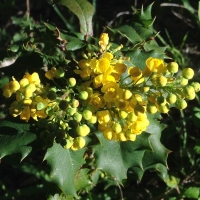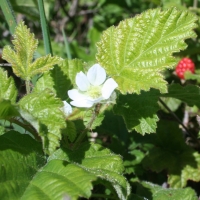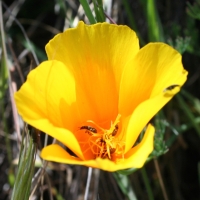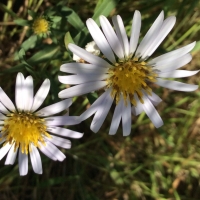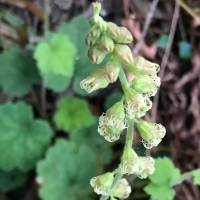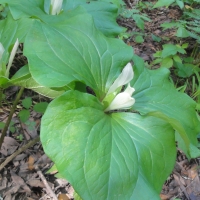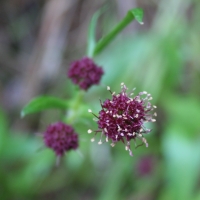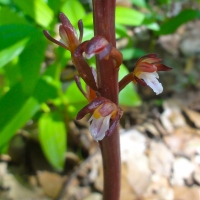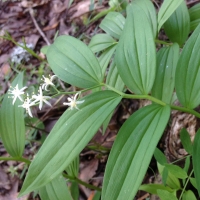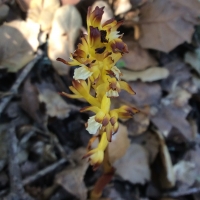NEW
– Barberry with its sweet smelling, bright yellow flowers is blooming next to the Amaranth Fritillaria patch and on the trail up to the ridge from the Indian warrior patch.
– California blackberry, a low vine, not the more robust bushy Himalayan blackberry with its delicious fruit, is blooming in the forests. It will be everywhere soon.
– California poppy will be blooming for many months and is showing its orange bell flower on Montford below Kerouac Hill.
– Common California aster is blooming on the Homestead trail.
– Coralroot is blooming above the trail in the big Indian warrior patch.
– False lily of the valley is carpeting the forest floor. A few have started blooming, soon the carpet will be bright with white star flowers.
– Fringe cups with its greenish fringed flowers is blooming next to the bridge on the Eagle trail.
– Giant trillium is blooming in a patch near the Oso berry on Homestead Trail East.
– Purple sanicle is blooming on the Eagle trail below Amaranth and near the Indian warrior patch.
– Yellow coralroot is blooming near the Indian warrior patch.
Forests
Starting
– Canyon gooseberry with its Chinese lantern-like flowers is blooming at the u-bend, right next to Ridgewood Ave., on the Madrone Park trail and along Homestead Trail East.
– Fairy Bells will bloom for months. The plants are up and fresh but only a few have blooms. Flower bells hang under the leaves and are usually impossible to see from our vantage, so turn over the leaves and peak underneath.
– Forget-me-not* the familiar pretty little blue flower, a European native, is starting to bloom now. This is one of our most successful invasives covering the forest floor and crowding out native species.
– Oso berry is flowering in the seep along the Homestead Trail East. Also know as Indian plum, this shrub produces edible fruit.
– Stinking iris, native to Western Europe, is blooming below Amaranth near the redwood grove.
Fading
– Fetid adder’s tongue, one of our most exotic and earliest spring wildflowers is blooming in its woodland locations. It grows in patches so, if you see one, look for more.
– Green wattle with its heady scent, is blooming with its yellow puff flowers. This native of Eastern Australia blooms after the first rains.
– Trillium, with its white flower in the center of three heart shaped leaves is blooming in the forest.
Forest Edges
Starting
– Checker lily is blooming along the Eagle Trail, going up, 8 steps past the little creek below 9e on the right.
– Douglas iris is blooming with purple and white blooms near the large Indian warrior patch at 9k.
– Ground iris is blooming white on the oak knoll after you cross the creek above 9d.
– Manroots or Wild cucumber is a native vine with white flowers that will soon be blooming all over.
– Pacific sanicle with its rich foliage and unspectacular dull yellow flower is blooming on the spur trail going up to 4-corners.
– Red maids, with its rich pink flower, is blooming along the trail to 4-Corners.
– Shooting star is blooming below the sign post at 9e with lots of buds nearby.
– Woodland strawberry is common at the forest edges where it is starting to bloom.
– Wood sweet cicely is abundant along all the woodland paths. Its small white blooms are appearing now. Once it goes to seed, the tender pods make a delicious trail snack.
Peaking
– Milkmaids, are just starting. This is a member of the mustard/radish family (edible).
– Pacific hounds tongue with its small blue flowers and large leaves is popping up all over and blooming at the edges of the forest and in shaded meadows.
Meadows
Starting
– Blue dicks, a soft blue cluster at the end of a long stem is bobbing blue on the way to Homestead Hill. There are many patches of it yet to bloom on the ridge trail and down in the brighter places along the Homestead Trail.
– Buttercup is blooming on the ridge and in some of the lower meadows.
– Checkerbloom is blooming up on the ridge near the patches of blue dicks.
– Chickweed, a native of Europe, is edible and nutritious, and is used as a leaf vegetable, often raw in salads.
– Common vetch, a native of the Mediterranean, is the purple pea blooming in the meadows
– Footsteps of spring is blooming up on the ridge and in open meadows.
– Death camus is blooming in woodland meadows, the whole plant is poisonous, hence the name.
– Greene’s saxifrage, one of the flowers in Homestead found only on the Ridgewood Rock is blooming there now. These tiny blooms stand atop long stems and bloom on the mossy shelves of the rock.
– Indian warrior is popping up in many locations but is only showing bright color at the large patch at 9k.
– Marin checker lily, distinguishable from the other checker lily by its rich chocolate color, is listed as rare, threatened, or endangered on the CNPS Inventory of Rare and Endangered Plants. It’s blooming in the meadow below Amaranth.
– Oakland star tulip, one of the rare plants in Homestead, is starting to bloom along the trails at the end of the canyon.
– Sourgrass, native to South Africa, is a noxious weed here. We used to suck on the sour juice in the stems when we were children and squeeze the juice onto our Miner’s lettuce salads as dressing.
– Spring gold, a bright yellow low cluster, is blooming just down the face of the Ridgewood Rock. We can look forward to lots more as the blooms come where it carpets the lower part of the rock.
– Sun cups is a bright yellow close to the ground in the meadows.
– White flowered onion*, native to the Mediterranean basin, is blooming in gutters and wet places. All parts of the plant from the bulb to the flower are edible.
– Wooly lomatium, with its hairy greenish disklike flowers grow close to the ground on the Ridgewood Rock and up on the ridge below Homestead Hill.
Key to map:
I haven’t located Chickweed, White flowered onion, Milkmaids, Forget-me-nots, American trailplant, Fennel, California Blackberry, California honeysuckle, Bay, Chickweed, Cleavers, Hedge parsley, Manroots, Swordfern, Sourgrass, Coyote brush, French or Scotch Broom on the map as they are so prolific.
Flowers that are not currently blooming have been removed from the map and are greyed out in the map key.
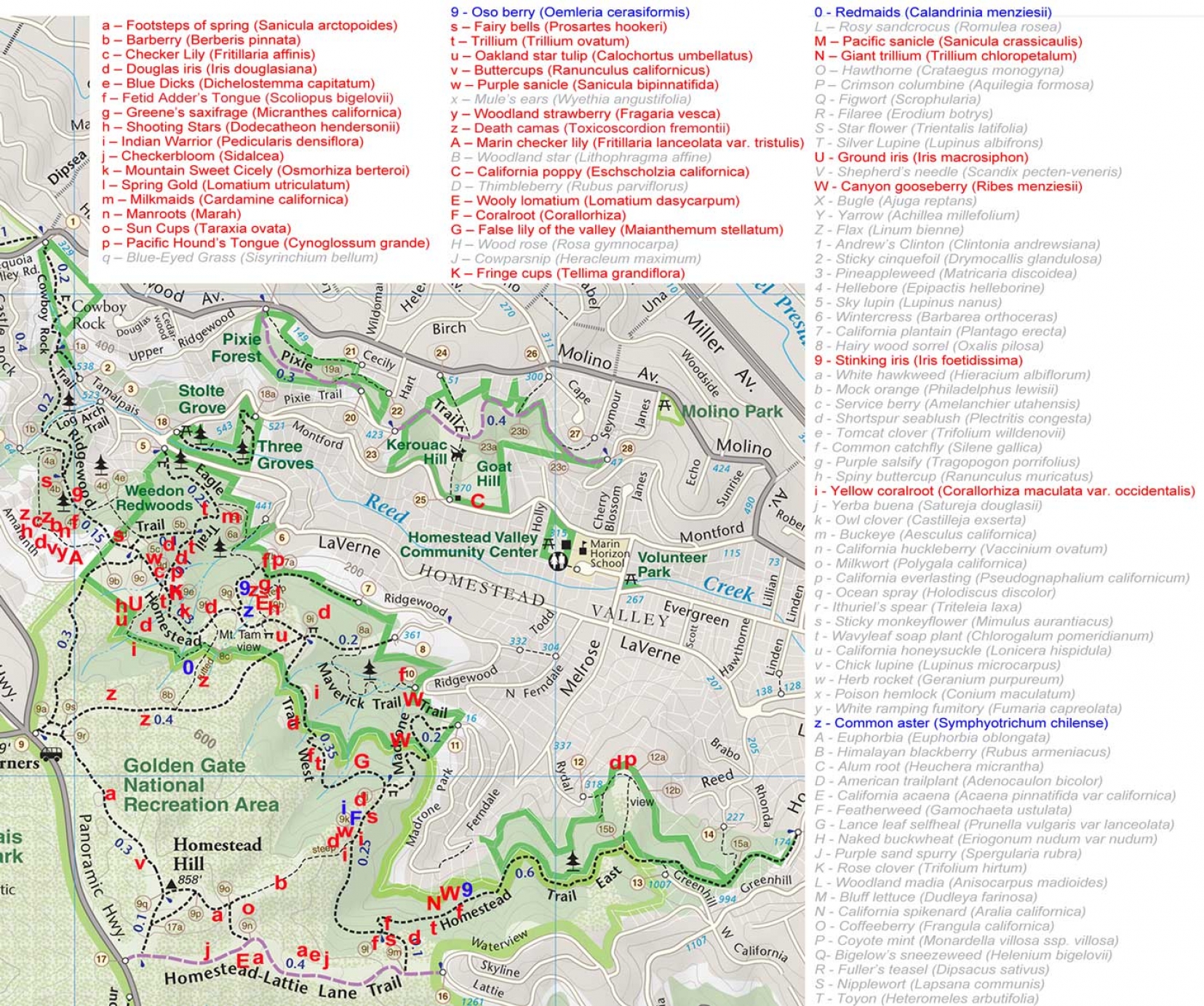
Gallery of wildflowers and plants found in Homestead.
*Non-native
Share this: